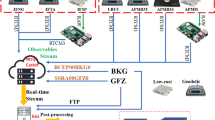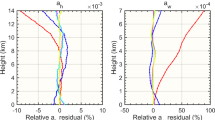Abstract
The feasibility of expanding the evaluation parameters was discussed when selecting the “Karadag” test site for the installation of millimeter-wave antennas based on the following: a comparative analysis of the data on the integral atmosphere moisture content in the time interval from August 2019 to January 2020 for the NIRFI NNSU “Karadag” test site, three IAA RAS test sites (“Zelenchukskaya”, “Svetloe”, and “Badary”) and the construction site of the 70-m radio telescope on the “Suffa” plateau (Uzbekistan) (average values for 1981–1991). This is due to the absence of places in the Russian Federation territory with consistently good atmospheric transparency in the millimeter-wave range, comparable to the Chahnantor plateau in Chile. Using the monthly average values of the integral moisture content as the main criterion for choosing a test site, one should consider both the characteristic of the wind rose at the “Karadag” test site and a more detailed daily and intraday distribution of moisture content. At the “Karadag” test site, even in summer, high transparency of the atmosphere periodically appears. Integral moisture content decreases to levels comparable to this parameter in the Suffa mountain area. The results obtained make it possible to correct the current principles for the placement of astronomical instruments and space communication systems of the millimeter and submillimeter-wave ranges in the territory of the Russian Federation.








Similar content being viewed by others
Notes
Free registration on the website is required to obtain data [5].
rp5.ru
REFERENCES
R. P. Bystrov, A. V. Petrov, and A. V. Sokolov, Zh. Radioelektron., No. 5, 3 (2000).
G. B. Sholomitskii, I. A. Maslov, and V. M. Grozdilov, Sov. Astron. 26, 358 (1982).
A. V. Lapinov, S. A. Lapinova, L. Yu. Petrov, and D. Ferrusca, in Millimeter, Submillimeter, and Far-Infrared Detectors and Instrumentation for Astronomy X, Proc. SPIE 11453, 114532 (2020).
I. T. Bubukin, I. V. Rakut’, M. I. Agafonov, A. L. Pankratov, A. V. Troitskii, V. A. Lapchenko, R. V. Gorbunov, I. I. Zinchenko, V. I. Nosov, and V. F. Vdovin, J. Exp. Theor. Phys. 129, 35 (2019).
https://cddis.nasa.gov/Data_and_Derived_Products/CDDIS_Archive_Access.html.
http://asc-lebedev.ru/index.php?dep=16\&suffa=3.
V. E. Panchuk and V. L. Afanas’ev, Astrophys. Bull. 66, 233 (2011).
https://wui.cmsaf.eu/safira/action/viewHome.
M. M. Beskaravainyi, N. S. Kostenko, L. P. Mironova, L. Ya. Partyka, V. N. Golubev, V. M. Zubarovskii, and A. M. Peklo, The Nature of Karadag (Naukova Dumka, Kiev, 1989) [in Russian].
A. V. Zuev, V. Yu. Letukhova, and E. A. Zueva, Tr. Karad. Nauch. Stants. im. T.I. Vyazemskogo—Prir. Zapoved. RAN 13, 77 (2020).
S. D. Snegirev, V. M. Fridman, and O. A. Sheiner, The First Radiophysical Institute in the Country (From Its Foundation to the Present Day) (FGBNU NIRFI, Nizhnii Novgorod, 2016) [in Russian].
I. T. Bubukin, M. I. Agafonov, I. V. Rakut’, A. L. Pankratov, A. A. Yablokov, A. V. Troitskii, A. S. Priimak, and R. V. Gorbunov, Radiophys. Quantum Electron. 62, 562 (2019).
V. M. Ivanova, V. N. Kalinina, L. A. Neshumova, and I. O. Reshetnikova, Mathematical Statistics (Vysshaya Shkola, Moscow, 1981) [in Russian].
V. Yu. Katkov, J. Commun. Technol. Electron. 42, 1344 (1997).
P. W. Rosenkranz, J. Quant. Spectrosc. Rad. Transfer 39, 287 (1988).
G. M. Bubnov, Yu. N. Artemenko, V. F. Vdovin, D. B. Danilevskii, et al., Radiophys. Quantum Electron. 59, 763 (2017).
http://iaaras.ru/quasar/wvr/.
G. N. Ilyin and A. V. Troitskii, Radiophys. Quantum Electron. 60, 291 (2017).
M. Bevis, S. Businger, T. A. Herring, C. Rocken, R. A. Anthes, and R. H. Ware, J. Geophys. Res. Atmosph. 97 (D14), 15787 (1992).
J. L. Davis, T. A. Herring, I. I. Shapiro, A. E. E. Rogers, and G. Elgered, Radio Sci. 20, 1593 (1985).
G. S. Kurbasova and A. E. Vol’vach, Nauka Vchera, Segodnya, Zavtra, No. 4, 79 (2016).
https://www.iram-institute.org/.
P. R. Jewell, ASP Conf. Ser. 278, 313 (2002).
Funding
This work was supported by the Ministry of Science and Higher Education of the Russian Federation (projects within the framework of the base part of the State Assignment of NNSU 0729-2020-0057, and IPM RAS 0035-2014-0206, as well as IBSS 0556-2019-0006).
Author information
Authors and Affiliations
Corresponding author
Additional information
Translated by E. Seifina
Rights and permissions
About this article
Cite this article
Bubukin, I.T., Rakut, I.V., Agafonov, M.I. et al. Comparative Analysis of the Propagation Conditions of Millimeter Radio Waves at Radio Astronomy Polygons in Russia and Uzbekistan. Astron. Rep. 65, 598–614 (2021). https://doi.org/10.1134/S1063772921080011
Received:
Revised:
Accepted:
Published:
Issue Date:
DOI: https://doi.org/10.1134/S1063772921080011




